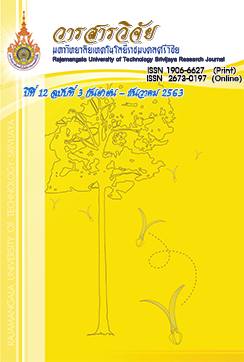Using Ishikawa Diagram to Analysis Causes of Survival of Microorganism in Steamed Ground Poultry Meat as Ingredient of the Blenderized Formula for Tube Feeding: A Case Study at Phatthalung Hospital
Abstract
Phattalung hospital with 445 patient beds had 22% of patients for tube feeding. The tube feeding products daily prepared from nutritional section had microbial quality within acceptable limits. But in September 2018, the internal audit by consumer protection section of Phatthalung hospital reported that Eschericia coli exceeded the acceptable limit in steamed ground poultry meat used as blenderized formula of breakfast tube feeding. Therefore, this research started to analyze and determine the cause of problems using Ishikawa diagrams. The analysis results showed four main factors that affected remaining Eschericia coli in steamed ground poultry meat. Risk identification stage showed that the method factor had the highest risk followed by raw material, staff and equipment, respectively. Improving the method by reducing the amount of fresh grounded poultry meat per steaming tray and controlling the steaming time that core temperature of steamed ground poultry should not be lower than 90 ๐C. Risk from raw material was prevented by only using Q mark fresh ground poultry meat. Sampling of staff and equipment showed microbial quality within acceptable limits. Therefore, Ishikawa diagram is an appropriate tool for identifying the root cause of a problem and leading to a guideline to solve the problem.
References
ผกามาส ปุรินทราภิบาล. 2561. การควบคุมคุณภาพอาหาร. เอกสารประกอบการสอน. คณะอุตสาหกรรรมเกษตร มหาวิทยาลัยเทคโนโลยีราชมงคลศรีวิชัย, นครศรีธรรมราช.
พงษ์เทพ วิไลพันธ์. 2558. จุลินทรีย์ก่อโรคความสำคัญต่อการปนเปื้อนในมิติต่าง ๆ. แหล่งที่มา: http://WWW.fish.ku.ac.th/Fish Pro/ pdf /3M-2558.pdf., 31 มกราคม 2563.
สุขุมา กลั่นแก้ว. 2544. การประยุกต์ใช้เตาไมโครเวฟสำหรับทำลายเชื้อในนมผสมและอาหารทางสายให้อาหารใน โรงพยาบาลสงขลานครินทร์. วิทยานิพนธ์วิทยาศาสตรมหาบัณฑิต สาขาวิชาอนามัยและสิ่งแวดล้อม, มหาวิทยาลัยสงขลานครินทร์.
สำนักงานตรวจสอบภายใน. 2552. คู่มือการบริหารความเสี่ยงทั่วทั้งองค์กร. พิมพ์ครั้งที่ 3. มหาวิทยาลัยเกษตรศาสตร์, กรุงเทพฯ.
ฮิโตซิ โอกุระ, วิเชียร เบญจวัฒนาผล และ สมชัย อัครทิวา. 2545. Why-Why Analysis เทคนิคการวิเคราะห์อย่างถึงแก่นเพื่อปรับปรุงสถานะประกอบการ. สมาคมส่งเสริมเทคโนโลยี (ไทย- ญี่ปุ่น), กรุงเทพฯ.
Berger, A. 2004. Smart Things to Know about Six Sigma. Capstone Publishing Ltd., United Kingdom.
Downes, P.W. and Ito, K. 2001. Compendium of methods for the Microbiological examination of foods 4th ed. American Public Health Association (APHA), Washington, D.C.
ISO. 2004. Microbiology of food and animals feeding stuffs-Horizontal methods for sampling techniques from surfaces using contact plates and swabs. ISO Norm 18593: 2004. International Organization for Standardization, Geneva, Switzerland.
Rhree, M.S., Lee, S.Y., Hillers, V.N., McCurdy, S.M. and Kang, D.H. 2003. Evaluation of consumer-style cooking methods for reduction of Escherichia coli O157: H7 in ground beef. Journal of Food Production 66(6): 1030-1034.
Singh, R.K. and Deshpande, D. 2018. Thermally induced changes in quality of chicken breast meat protein fractions. Journal of Nutrition and Food Science 8(4): 1-5.
U.S. Department of Agriculture. 1998. Final Report: Focus Groups on Barriers that Limit Consumers’ Use of Thermometers when cooking Meat and Poultry Products. United States Department of Agriculture Food Safety and Inspection Service, Washington, D.C.
Downloads
Published
How to Cite
Issue
Section
License
The content and information in the article published in Journal of Rajamangala University of Technology Srivijaya It is the opinion and responsibility of the author of the article. The editorial journals do not need to agree. Or share any responsibility.







